Homeless in Cumberland County – Fayetteville? The Lies Run Rampant!
Fayetteville, N.C. – Every odd year much fuss is made of a federally mandated practice required to keep receiving federal HUD funds. It is called the Point in Time (PiT) count of alleged ‘homeless’ within a given geographical area, usually a county. These counts are conducted by entities known as a Continuum of Care (CoC), the Cumberland County Continuum of Care (CCCoC) in the Fayetteville/Cumberland County area.
Counties or regions must create Continuums of Care if they want to apply for the U.S. Department of Housing and Urban Development’s (HUD) McKinney-Vento funds for homeless programs. Individual agencies are not able to apply – they must go through a CoC.
There are thirteen Continuum of Care groups in North Carolina. Typically the larger cities develop their own CoC and the rest of the state merges into one CoC called the Balance of State. The Balance of State acts as a CoC and is allowed to apply for HUD McKinney-Vento funds.
When the average citizen thinks of ‘homeless’, they imagine an innocent person or family, destitute through no fault of their own and living in a tattered tent made of garbage bags, a cardboard box or a car because they fell on hard times and lost their job or were victims of a natural disaster.
But is this really the definition that the CCCoC uses when they perform this mandated bi-yearly count?
Hardly.
A deep dive into this issue has revealed that the CCCoC strive to count as homeless;
- Those exceedingly rare few truly homeless who through no fault of their own have been forced into living in a tent made of garbage bags, a cardboard box or a car because they fell on hard times and lost their job or were victims of a natural disaster.
- Those who seek to take advantage of American generosity, those who should more rightfully be referred to as vagrants, beggars, moochers, con artists, and thieves who selfishly seek only to fulfill their need to get high or drunk.
- Those who seek to live in a house and be fed off the hard earned tax dollars or charitable contributions of others because they do not think they should have to work, because they believe in socialism, or they view it as a form of racial reparations.
- Those who are mentally defective and would be better served institutionally committed rather than simply given a place to live that they ultimately destroy.
- Those school children who live with relatives, who ran away to live on their own, who have been court ordered to live with someone other than their own family, or who simply live in a home that is not as nice as the home you live in.
One of the big lies is that these ‘homeless’ that are counted have no place to live. But the criteria that’s used to define homeless is quite different from what you expect.
The label ‘homeless’ has been sub-divided into two categories;
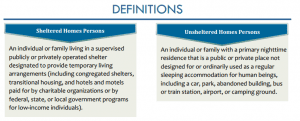
Sheltered Homeless People? How can one be living in a shelter, housing, hotels and motels and be considered homeless? They have a place to live and usually on your hard earned tax dollars. If not on your tax dollars then certainly on your hard earned church tithing and charitable donations. The whole system is really nothing more than just another welfare venue sucking your hard earned dollars down a bottomless pit.
Just how many “homeless” are there in the Cumberland County community? I mean the truly homeless who did not choose that condition and who did nothing to deserve that condition and are actually driven to be out in the cold with no shelter at all.
No one has any problem assisting the truly homeless. It is a solid immutable part of American culture to help the helpless whenever possible. Those whom people take exception with are the ones who seek to take advantage of American generosity, those who should more rightfully be referred to as vagrants, beggars, moochers, con artists, and thieves. The ones that choose to live the life of the drunken and drugged whose only goal is to acquire their next bottle or fix. The ones that are not “homeless” because even if you gave them a house to live in they would not take responsibility for it or care for it. They would destroy it leaving urine and fecal matter in EVERY room and create an environment for disease and rodents. Law enforcement has reported seeing this many times.
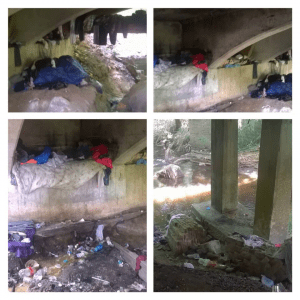
Those homeless you still see at the street intersections in the city begging for money have been offered shelter, food and work many times on at least a weekly basis. These misfit dregs of society have essentially refused help because it’s not help that they want. They want money in hand so they can go to the nearest street drug dealer or convenient store and buy the substance they want the most, beer and illegal drugs. They can make as much as they need as quickly as they need panhandling, perhaps $10 to $20 dollars an hour. If they didn’t get enough panhandling to support their addictions, they would have left long ago.
Another misrepresentation is that a large number of these ‘homeless’ have nowhere to go and that’s why you see stories about them being found living under bridges, in cars, in garbage bag tents or cardboard boxes. This is also not true. Law enforcement often reports that their numerous attempts to get these individuals into shelters and other programs are steadfastly refused because these people know that they will not be able to keep their drugs and alcohol and get high or drunk in these shelters, transition homes or other roofs over their heads. They choose to live outdoors under the bridges, in cars, in cardboard boxes or abandoned buildings so they can freely imbibe in their drug of choice unhindered.
Not seen in this community is anyone who is skin and bones from lack of food or water except for the effects of certain drugs to which they are addicted. No one has ever heard of any of these so called “homeless” starving to death in Fayetteville, at least in recent memory. A thorough search did not locate a police death investigation report describing any ‘homeless’ person found starved to death.
Law enforcement officers have dealt with and listened to these people and listened to them for far longer than newspaper editors, reporters and liberal shysters trying to collect your money have. Law enforcement can readily recount to you how they have heard from these community degenerates all about how it didn’t matter to them that they stole from others, scared others, thought it was funny to beg for food and then spend the money on alcohol and drugs. Street officers will assure you that these people on the streets are not your friends. They are users, manipulators, deceivers, and criminals.
In many ways your heart strings are being ruthlessly plucked for no more reason than unethical monetary gain.
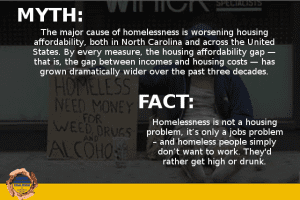 | 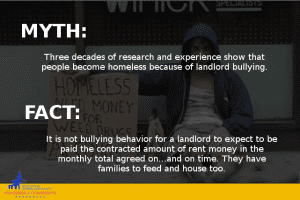 |
CCCoC has a penchant for a Chicken Little-esque ‘The sky is falling’ attitude regarding homelessness in Cumberland County as evidenced by their now debunked prediction on page 31 of their “Action Plan”.
“The 2017 Point-In-Time Homeless Count information is not available at this time. However, it is anticipated that the total number of homeless persons living on the streets or chronically homeless has increased from the previous year.”
The reality is that homelessness in Cumberland County has been steadily decreasing since 2014 and is projected to continuing doing so by the experts…at least those whose paychecks don’t depend on the ‘Chicken Little’ false narratives.
Nothing supports this contention more than the recently released CCCoC 2017 Summary Report which is rife with desperation, misrepresentation, conflicting data errors (strangely always depicting a worse situation), and manipulative omissions of relevant data.
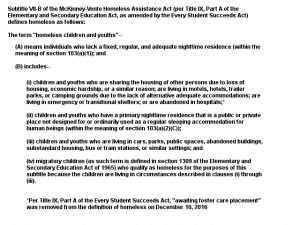 First noticed is the desperate attempts to make sure that the reader comes away with the impression that the alleged homelessness is still a very bad problem in this community.
First noticed is the desperate attempts to make sure that the reader comes away with the impression that the alleged homelessness is still a very bad problem in this community.
The CCCoC 2017 Summary Report complains that,
“640 students from Cumberland County Schools are not included in the PiT Count, but they are indicated in this report as meeting The McKinney-Vento Education Assistance Act’s definition of homelessness.”
EXCEPT; The HUD mandated biennial Point in Time Homeless count does not follow the McKinney-Vento Education Assistance Act’s definition of homelessness and never has. HUD has its own definitions and enforces them.
North Carolina school systems have been recognized by HUD as having a much too liberal definition of ‘homeless’ under the McKinney-Vento Education Assistance Act by trying to count as homeless children those who are;
- Living with friends, relatives or someone else
- Living in substandard housing
- Awaiting placement in foster care
- Youth living on their own, even if their families want them to come home.
Apparently if a child lives in a house in Bonnie Doone as opposed to a house in Kings Grant they are considered ‘homeless’ by Cumberland County school systems because they are viewed as living in ‘substandard housing’.
PIT Count Methodology Guide – Page 62 – Since schools use a more expansive homeless definition than HUD’s definition used for the PIT count, it is important to confirm that only children and youth meeting the HUD definition are included in the PIT count results reported to HUD.
This misdirection by the substitution of another set of definitions in this summary report is quite unethical and the CCCoC should be called to the carpet to explain themselves in this matter.
There can be no doubt that these acts committed by the CCCoC certainly presents a reasonable suspicion that they may commit acts to skew the PiT counts in order to fit their agenda.
It is interesting that the CCCoC chose to release a “summary report” instead of simply releasing the actual data and letting those interested draw their own conclusions based on the facts…not the CCCoC’s interpretation of what they think you should see. [Actual data provided at end of article after sources]
Quite frankly actions like this lead one to believe that the CCCoC is only interested in inflating the data in a surreptitious attempt to keep the federal funding and their paychecks coming.
CCCoC further complains that,
“The PiT does not include individuals or families who only meet the definition of homelessness under other federal statutes. Therefore, persons precariously housed, “doubled-up”, or “couch surfing” (meaning persons who are sharing the housing of others due to loss of housing, economic hardship, or a similar reason) are not considered literally homeless according to HUD’s definition.”
Well, they shouldn’t be counted as homeless if they are living with family members, or even friends, until they’re on their feet again. That’s how it’s supposed to work. Family members have a duty to assist their own family members if they fall on hard times. This is simply not a duty that should fall on the taxpayers via government.
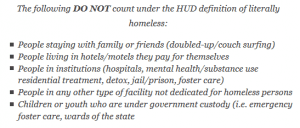 Clearly HUD is increasingly tightening up their definitions of homeless because President Trump’s administration is demanding that the federal government become far better stewards of taxpayer dollars than they have been in the past.
Clearly HUD is increasingly tightening up their definitions of homeless because President Trump’s administration is demanding that the federal government become far better stewards of taxpayer dollars than they have been in the past.
When one realizes that the only reason that HUD published these specifics regarding just who IS NOT homeless; It is because someone somewhere was caught artificially inflating their PiT counts by unethically trying to count these people.
Hurricane Matthew brushed the North Carolina coast September 28, 2016 causing 10 inches of rain to fall in the area. CCCoC would have you believe that an occurrence eight months ago is still relevant in a country, and state, as advanced North Carolina, U.S.A.
“Not all of the persons affected by Hurricane Matthew, and living in hotels, are included in the PiT – specifically because the information was not available or accessible during that period. Therefore, only 30 persons are counted, even though approximately 204 households were staying in the hotels during this time.”
This is a very disingenuous misrepresentation in that the highest probability is that the vast majority of those 204 households were rebuilt/repaired by insurance companies and the occupants have moved back into their homes. The remaining 30 alleged are more likely the result of individuals who are freeloading on your tax dollars or charitable contributions.
The CCCoC then strangely insists that you ignore the factual data and puts forth an emotional demand;
Given these limitations, and the differences in PiT counts across the years, it is important to interpret these findings as estimates and not precise counts; nor should they be inferred as exact increases or decreases in the homeless population. Rather, consider it a tool for looking at aggregate trends, examining the many different characteristics of our homeless population, and as a mechanism for identifying the needs of Cumberland County-City of Fayetteville’s homeless population.
EXCEPT: HUD does in fact believe these PiT counts to be valuable indicators of increases, or decreases as in Cumberland County’s case, otherwise HUD would not mandate the counts and utilize the information to strategically utilize manpower, taxpayer dollars and other resources. It is very curious that the CCCoC is so dismissive of a tool that HUD mandates, such dismissiveness leading people to believe that the CCCoC does not have the Cumberland County taxpayers’ interests at heart. Many question how a mere 14/100 of one percent homelessness constitutes ‘need’ in Cumberland County for a CoC or federal funding.
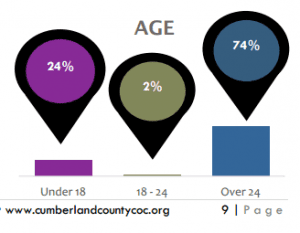
One important question on everyone’s mind is,
“How many children are homeless in Cumberland County?”
A simple question deserving of a simple answer.
However a simple answer is not obtainable due to the confusing wordplay and intentional obfuscation of the actual data collected as the unmanipulated raw data collected did not serve to support the CCCoC’s agenda.
The legal definition of a ‘child’ is a person 14 years and under. A “child” should be distinguished from a “minor” who is anyone under 18 in almost all states. Yet by unethical wordplay the CCCoC would have you believe that anyone under the age of 25 is a child or youth. There are thousands of U.S. Military members and veterans who would take exception to such a label being placed on them.
Page 9 of the CCCoC 2017 Summary Report cites that 24% of the homeless are under 18 which should equate to 106 homeless ‘children’ (youths) under the age of 18.
However, the 2017 PiT Summary Youth Populations Report received from Dee Taylor, Community Services Manager, Cumberland County Community Development, shows that there are no children under 18years of age that are truly homeless in Cumberland County.
In yet another data set comprised by the CCCoC we find that the CCCoC reported to HUD that there are 12 homeless 18 years of age and under in emergency housing, 77 homeless 18 years of age and under in transitional housing, 16 homeless 18 years of age and under are listed as ‘unsheltered’ for a total of 105 children under 18 years of age that are claimed to be homeless. This conflicts with the cited ‘24%’ (106) mentioned in their summary report. So the answer could be either “106”, “105”, “16” or “0” depending on whether you read the ‘summary report’ or view the actual data forwarded to HUD.
Clearly getting a straight answer out of CCCoC regarding if there are any truly homeless children living in a tattered tent made of garbage bags, a cardboard box or a car because they, or their parents, fell on hard times through no fault of their own is like herding cats… in the middle of the night…during a thunderstorm.
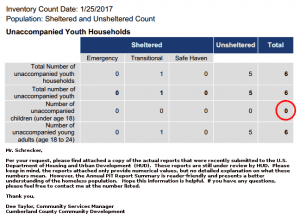 | 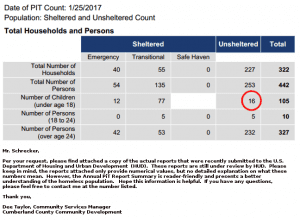 |
Such mistakes, misdirection and manipulations simply do not engender trust in the reliability of the CCCoC Summary Report. If they are in emergency housing then they are certainly not homeless. If they are in transitional housing then they are certainly not homeless. And just where do these alleged 16 homeless children under 18 come from when the CCCoC reports to HUD that there are zero homeless children in Cumberland County?
Another misrepresentation of fact is the definition of “Youth”. The CCCoC Summary Report claims “Youths” are any person less than 25 years of age.
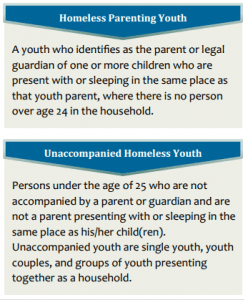 In North Carolina any person at 16 years of age can sign college contracts, obtain a driver’s license, is considered an adult in a court of law, and any person in North Carolina reaches the ‘age of majority’ at 18 years of age. Clearly anyone between the ages of 16 and 25 are not ‘youths’ or ‘children’. This unethical manipulation by wordplay is designed to make it easier to fool you into thinking that children are in danger for the sole purpose of separating you from your tax and charity dollars.
In North Carolina any person at 16 years of age can sign college contracts, obtain a driver’s license, is considered an adult in a court of law, and any person in North Carolina reaches the ‘age of majority’ at 18 years of age. Clearly anyone between the ages of 16 and 25 are not ‘youths’ or ‘children’. This unethical manipulation by wordplay is designed to make it easier to fool you into thinking that children are in danger for the sole purpose of separating you from your tax and charity dollars.
In another inflationary misrepresentation of the truth the CCCoC summary report plaintively cries that veterans are a whole 9% of the total homeless population and that 7% are ‘shelterless’. One wonders just how significant a nine percent slice out of the paltry 0.14%, (not 14 percent, but 14 one hundredths of one percent), of the county population that is homeless can possibly be? In reality that’s only 40 people out of 327,127 people (31 out of 327,127 people ‘shelterless’).
Even more disturbing is the fact that the only ‘proof’ that these people are veterans is their word alone. They are simply asked the question “Have you served in the United States Armed Forces (Army, Navy, Air Force, Marine Corps, or Coast Guard)?” Their answer is never researched and validated. Any law enforcement officer can tell you that these so-called homeless will certainly lie and tell you that they are vets if they think that it will generate sympathy and get you to come across with the money for their drugs or alcohol or get them out of an arrest.
Then there’s the misrepresentation that there is a 49% “bed gap”. This is supposedly the difference between the number of people declared ‘homeless’ by the CCCoC (442) and the number of shelter beds available which is currently listed at 215 according to CCCoC. But the raw unmanipulated data shows that there are 189 persons who are in emergency or transitional beds leaving 26 beds empty.
Why is there a surplus of 26 beds if there is such a desperate need? Why haven’t 26 of the alleged 253 ‘unsheltered’ homeless, especially those alleged 16 homeless children under 18 years of age, occupying those underutilized beds? How is it possible that there are 16 children living in tents made of garbage bags, cardboard boxes or a cars, abandoned buildings or out in the the open weather when there are 26 surplus beds available? If there are really 16 children in such a situation and nothing has been done about it then law enforcement needs to respond and take the appropriate actions.
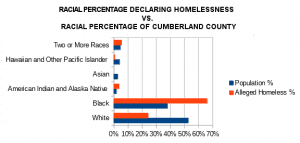 One disturbing aspect of the alleged homelessness in the Fayetteville/Cumberland County area is the disproportionate number of Blacks who are claiming to be homeless.
One disturbing aspect of the alleged homelessness in the Fayetteville/Cumberland County area is the disproportionate number of Blacks who are claiming to be homeless.
Members of the community are questioning the legitimacy of so many Blacks actually being homeless and wonder if they aren’t actually playing the system and tricking good-hearted charitable community members into paying for them a place to live. A way to sneakily extract unwarranted racial reparations from those who were never guilty in the first place.
This factor alone has many in the Cumberland County community calling for an audit of CCCoC’s monetary dispersals and review of the patterns and practices of the CCCoC with regard to adherence to HUD policies, rules, and regulations. To think that Blacks in the community are more prone to homelessness simply due to race, or as a race, would be racist indeed. Therefore, a reasonable suspicion that there is an institutional favoritism towards Blacks with regard to the CCCoC does certainly present itself.
In another troubling discovery a careful study of the Cumberland County 2017 Annual Homeless Action Plan reveals that while there are plenty of references to advertising for money, to many avenues for the solicitation and collection of tax dollars and charitable contributions, and to the creation and building of ‘homes’ for the homeless by solicited donations of charitable unpaid time and labor, there is not one mention of the word ‘job’ within the whole action plan.
Experts believe that the fastest and surest way to not only raise a person out of homelessness, but keep them from recurrent homelessness, is for them to get a job. Many in the Cumberland County community are wondering just why this is not the number one goal in the CCCoC’s action plan. If the CCCoC wants to create lasting change in this community’s very minor homeless issue then they should be offering jobs and not places to live. With a job these people can pay for their own place to live…just like everyone else.
The only time the word ’employment’ is mentioned is in a standardized mission statement copied from the Code of Federal Regulations, Title 24, Housing and Urban Development (pg 546). Not one yearly goal in the Action Plan deals with putting these people into jobs. Putting them into ‘free’ houses, yes, but not into jobs. There is simply no attempt what-so-ever to get these so-called homeless off taxpayer funded assistance by steering them into jobs.
Why hasn’t it occurred to the CCCoC yet to take all these ‘homeless’ who are standing on the street corners begging for money for food and offer to pay them in food and shelter to work on Habitat for Humanity homes? After all, don’t their signs say they will work for food?
In summary, considering the unethical misrepresentation of data, the inconsistencies and errors with regard to the CCCoC’s “Summary Report” vs. the data they actually sent to HUD, and finally the fact that homelessness is clearly a very minor problem in Cumberland County (if can be said to be a problem at all), there really doesn’t appear to be a need for Cumberland County to even have a CoC.
The significant savings from closing the CCCoC and having Cumberland County become a part of the ‘Balance of State’ could be applied to those who are truly in need rather than wasted on unnecessary salaries, faulty unnecessary ‘summary’ reports and would certainly reflect a better stewardship of taxpayer dollars and charitable contributions.
Sources
- Cumberland County 2017 Annual Homeless Action Plan – http://www.co.cumberland.nc.us/community_dev/downloads/2017/Citizen_Participation_Report_AAP__2017.pdf –
- CoC Homeless Populations and Subpopulations Reports – https://www.hudexchange.info/programs/coc/coc-homeless-populations-and-subpopulations-reports/?filter_Year=&filter_Scope=CoC&filter_State=NC&filter_CoC=&program=CoC&group=PopSub
- Fayetteville/Cumberland County 2017 Pointin-Time-Count – http://www.co.cumberland.nc.us/community_dev/downloads/2017/Annual_PIT_Report_Summary__2017.pd
- Unsheltered Count Form for Night of Count – https://www.hudexchange.info/resources/documents/Model-Interview-Based-Unsheltered-Night-of-Count-PIT-Survey.pdf
- U.S. Census Quick Facts Cumberland Co. N.C. – https://www.census.gov/quickfacts/table/PST045213/37051/embe
- Point-in-Time Count Methodology Guide 2014 – https://www.hudexchange.info/resources/documents/PIT-Count-Methodology-Guide.pdf
- Cumberland County Schools Social Work – socialwork.ccs.k12.nc.us/homelessness
 |  |


